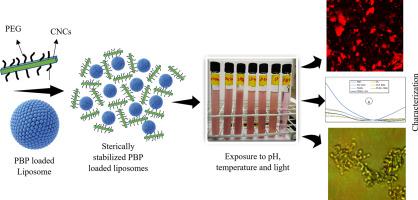International Journal of Biological Macromolecules ( IF 8.2 ) Pub Date : 2020-06-30 , DOI: 10.1016/j.ijbiomac.2020.06.262 Avinash Singh Patel 1 , SuriyaPrakaash Lakshmibalasubramaniam 1 , Balunkeswar Nayak 1 , Carl Tripp 2 , Abhijit Kar 3 , Praveen Kumar Sappati 1

|
This study ascertained the stability of phycobiliprotein (PBP), a bioactive protein from Dulse (Palmaria palmata) loaded within liposomes and stabilized with polyethylene glycol (2000 and 4000 g/mol) and desulfated CNCs (DCs) containing adsorbed polyethylene glycol (DCs-2000 and DCs-4000). The effect of pH, temperature and illumination on the stability of PBP was investigated. Results showed that the temperature had the most significant (p < 0.05) effect on the fluorescence intensity of the PBP, accounting for up to 70% loss of the fluorescence intensity for PBP loaded liposome (PL), PL stabilized with PEG-2000 (PLP-2000) and PEG 4000 (PLP-4000) and PL stabilized with desulfated CNCs (DCs), however, 60% for the PL stabilized with PEG 2000 and PEG 4000 adsorbed CNCs (PLDCs-2000 and PLDCs-4000) at 60 °C compared to those stabilized at 4 °C. A further increase in temperature to 80 °C led to a complete loss of fluorescence. Operating at the extreme pH's of 1.0 and 11.0 resulted in a loss of 90% and 30% fluorescence intensity, respectively for PBP in solution, whereas, 20% and 2% loss was observed for PBP incorporated inside the liposomes. Regarding the effect of illumination, PLDCs-2000 and PLDCs-4000 were the most stable, retaining the fluorescence intensity of PBP up to 70% after 72 h of exposure. This is compared to 85% loss of fluorescence for PBP in solution. Furthermore, at pH of 1.0, there was an increase in average particle size for the PLDCs-2000 and PLDCs-4000 from 189 ± 3 & 206 ± 2 nm to 6464 ± 211 & 6698 ± 317 nm and a charge reversal in the zeta potential from −36 ± 1 & −34 ± 2 to +16 ± 3 & +14 ± 1. Confocal and optical microscopic images confirmed the coalescence of PBP loaded liposome and agglomeration PLDCs-2000 and PLDCs-4000 under acidic pH (<3.0). In contrast, changes in temperature from 4 °C to 100 °C and illumination as a function of time up to 72 h resulted in no change in liposome size and zeta potential.
中文翻译:

聚乙二醇吸附的纤维素纳米晶体稳定的脂质体内藻胆蛋白的稳定性得到改善。
这项研究确定了藻胆蛋白(PBP)的稳定性,藻胆蛋白(Dulse(Palaria palmata))装入脂质体中,并用聚乙二醇(2000和4000 g / mol)和含有吸附的聚乙二醇的脱硫CNCs(DCs)(DCs-2000和DCs-4000)稳定。研究了pH,温度和光照对PBP稳定性的影响。结果表明,温度对PBP的荧光强度影响最大(p <0.05),占装载PBP的脂质体(PL)的荧光强度损失高达70%,用PEG-2000(PLP)稳定的PL -2000)和PEG 4000(PLP-4000)和PL用脱硫的CNCs(DCs)稳定,但是,在60°C下用PEG 2000和PEG 4000吸附的CNCs(PLDCs-2000和PLDCs-4000)稳定的PL的60%与稳定在4°C的相比。温度进一步升高至80°C导致荧光完全消失。在极限pH下运行 1.0和11.0的s分别导致溶液中PBP的荧光强度损失90%和30%,而掺入脂质体内部的PBP观察到20%和2%的荧光强度损失。关于照明的效果,PLDCs-2000和PLDCs-4000是最稳定的,在暴露72 h后,PBP的荧光强度保持高达70%。相比之下,溶液中PBP的荧光损失为85%。此外,在pH值为1.0时,PLDCs-2000和PLDCs-4000的平均粒径从189±3&206±2 nm增加到6464±211&6698±317 nm,并且zeta电位反转从-36±1和-34±2到+16±3和+14±1。共聚焦和光学显微图像证实了在酸性pH值(<3.0)下装载PBP的脂质体和聚结PLDCs-2000和PLDCs-4000的聚结。



























 京公网安备 11010802027423号
京公网安备 11010802027423号